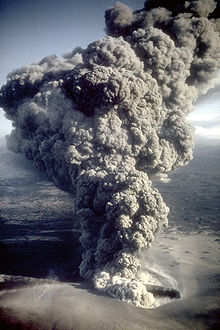
Back مار (جيولوجيا) Arabic Maar AST Maar Azerbaijani Маар Byelorussian Маар Bulgarian Maar Catalan Маар CE Maar Czech Maar Danish Maar German
This article needs additional citations for verification. (May 2024) |
Look up maar in Wiktionary, the free dictionary.


A maar is a broad, low-relief volcanic crater caused by a phreatomagmatic eruption (an explosion which occurs when groundwater comes into contact with hot lava or magma). A maar characteristically fills with water to form a relatively shallow crater lake, which may also be called a maar.[1]
Maars range in size from 20 to 3,000 m (66 to 9,800 ft) across and from 5 to 200 m (20 to 700 ft) deep.[2][3] Most maars fill with water to form natural lakes. Most maars have low rims composed of a mixture of loose fragments of volcanic rocks and rocks torn from the walls of the diatreme.[3]
- ^ David S.G. Thomas and Andrew Goudie (eds.), The Dictionary of Physical Geography (Oxford: Blackwell, 2000), 301. ISBN 0-631-20473-3.
- ^ Lorenz, V. (October 1986). "On the growth of maars and diatremes and its relevance to the formation of tuff rings". Bulletin of Volcanology. 48 (5): 265–274. Bibcode:1986BVol...48..265L. doi:10.1007/BF01081755. S2CID 128423499.
- ^ a b Lorenz, Volker (January 2007). "Syn- and posteruptive hazards of maar–diatreme volcanoes". Journal of Volcanology and Geothermal Research. 159 (1–3): 285–312. Bibcode:2007JVGR..159..285L. doi:10.1016/j.jvolgeores.2006.02.015.
© MMXXIII Rich X Search. We shall prevail. All rights reserved. Rich X Search